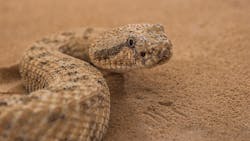Roboticists and Biologists Learn from Sidewinder Rattlesnakes
Researchers at the Georgia Institute of Technology, with help from Carnegie Mellon University, Oregon State University, and Zoo Atlanta, studied sidewinder rattlesnakes climbing an inclined bed of sand and a robotic snake trying the same feat to gain insights into a pair of age-old mysteries. Biologists have never fully understood how sidewinders climb up granular materials like sand just by twisting and coiling their bodies, and engineers have never been able to replicate the sidewinder’s capabilities in a robot.
The multidisciplinary team used high-speed videos to study how sidewinders climbed sandy slopes in an enclosure with a floor that could be inclined at various angles. They also studied how a robotic snake developed at Carnegie Mellon University moved in sand on flat and inclined sandy surfaces. The 37-in. long robotic snake has a 2-in. diameter and its body consists of 16 joints, each one arranged perpendicular to the ones next to it. This lets the robot move using a variety of gaits.
At first, the robot could use one component of sidewinding motion to move across sand, but could not climb an incline. Further study of the actual snake revealed that its movement was somewhat like a tank equipped with a revolving tread. As the tread circulates around the tank’s wheels, it lays down track in front and picks it up in the rear while treads in the middle remain momentarily stationary. Sidewinders also lift some body segments while others remain stationary on the ground. But the snake uses a gait that sets up two orthogonal “tread patterns” that it controls independently. This lets it go in any direction it wants. To climb slopes, the sidewinder compresses its body so that more of its scales are in contact with the ground as the sandy surface gets steeper.
After reprogramming the robotic snake with the orthogonal tread or wave pattern, it could climb sandy inclines. The research could be used to improve search-and-rescue robots and planetary rovers that are often tasked with moving over loose sand, gravel, and rubble.
Researchers have also examined how turtle hatchlings, crabs, sandfish lizards, and other animals move across complex surfaces such as leaves and loose material to gain insights into improving robotic locomotion.
